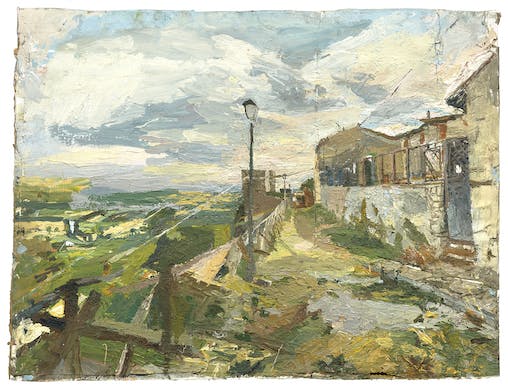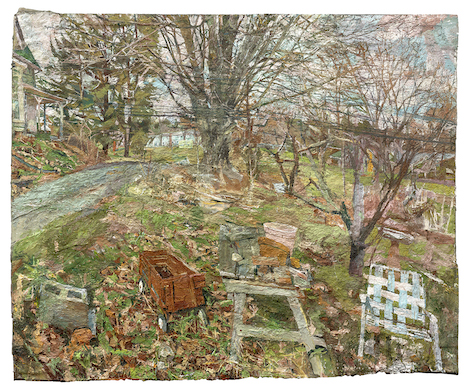These Microcosms and Macrocosms Offer New Experiences
Can a painter accommodate sweeping views and minute detail in a single work, and do justice to both? Stanley Lewis is fearless and tireless in proving he can.

Stanley Lewis: Paintings and Works on Paper
Betty Cuningham Gallery
May 12-July 1, 2022
When it comes to modern and postmodern art, much is made of process: how and why an image is made, the meaning of a work’s materiality, the historical context of the artist’s approach. Less frequently considered is the process of seeing — how the artist absorbs the world before ever touching pencil to paper or brush to canvas.
Stanley Lewis, a painter of rough-hewn landscapes, street scenes, and interiors, has spent several decades thoroughly combining processes of seeing and making. The 80-year-old’s fourth exhibition at Betty Cuningham puts on display his unique brand of messy eloquence; the work evinces at once the struggles of any honest painter to grasp the wide world and — what’s more important — an uncanny ability to make sense of it.
The scenes depicted in the artist’s 12 recently completed paintings and drawings are populated, as is his habit, by the most ordinary of objects: houses, cars, lawn chairs, telephone wires, and poles. Mr. Lewis will work onsite for months or sometimes even years on a single painting, intending, as he has claimed, to paint “every blade of grass.”
His twin allegiances — to the raw, granular sensations of nature, and to the pictorial needs of painting — would be challenging for any painter, but in his case they’re often complicated by his enthusiasm for fairly wide-angle views. Can a painter accommodate sweeping views and minute detail in a single work, and do justice to both?
Mr. Lewis is fearless and tireless in proving he can, in the process discarding such niceties as conventional linear perspective and illusionistic modeling. The struggle shows in his very heavily reworked surfaces, which have often been sliced apart and re-layered.
In fact, the most poignant aspect of these works lies in how respectfully these extreme techniques serve a greater purpose: a visual comprehension of the subject at hand. While his surfaces suggest a certain flailing, his compositions reflect something closer to endless, patient probing.
This is evident In the extraordinary painting “Backyard with a Wagon, Table and Chair” (2022), in which these three objects join in a grand sequence sweeping across the foreground, practically at the feet of the onlooker; they radiate toward the viewer, as if tethered by the painting’s brightest note: a row of distant, glimmering townhouses, beyond the rise of a road and bracketed by trees. Each of these elements — indeed, every detail in the painting — has twin lives, as both independent object and artifact of the artist’s organizing eye.

Mr. Lewis’s palette is largely restrained to tawny greens, ochres, off-whites, and steely blues, laced by the occasional sienna-red. These are more than enough to locate the distinct character of all the objects — the actors, so to speak — in a landscape of Monte Castello, Italy. Here, a lone, brave lamppost ascends above a gap between houses, placed tangibly in the depths by a roiling foreground of greenish and reddish ochres. Meanwhile, even more distantly, a farmhouse nests among more luminous greens and yellows.
With similar frankness and intensity, Mr. Lewis asserts, amid a blizzard of brushstrokes, the main elements of “View of the Garden with Orange Fence II” (2020): the lawn chair staring back at us from across a deep apron of fallen leaves; the stout, looming facets of a house beyond.
In all these paintings, faithful observations become fodder for pictorial life. Details teem, and vectors emerge — whether they’re wires, fallen stalks, roots, or stairways — to make them meaningful. Throughout, Mr. Lewis preserves an impression of large forces — sky, receding ground plane, verticals of trees and houses — anchoring tapestries of optical events. The artist’s attack is improvisational and sparked by whatever nature offers, which makes every drawing and painting in the exhibition a new experience.
Occasionally, profusions of sensations dilute the impression of greater, ordering powers. But then there’s the pen and ink drawing “View of Our House with Rhododendrons” (2022), which captures all the dense, exuberant textures of the subject while preserving distinct identities: a leafless shrub rising in front of a hedge, placed before another, darker hedge, which sits in turn before the façade of a house that lies beneath a branch-crossed sky. In the extreme lower corner, limned in ghostly faint lines, a cart converses with the crisp geometry of the house glimpsed through layered leaves. The image is busy and quite dark, its mark-making anxious, but the scene feels luminous, almost majestic, in its mysterious comprehension of forms.
There have been artists — Pieter Bruegel comes to mind — who could capture streaming panoramas as well as rivulets of detail, who could combine macrocosms and microcosms in one naturally unfolding vision. The key is not simply the counting of details, but making them count. Stanley Lewis’s oddly noble paintings provide far more than a hint of such remarkable possibilities.

